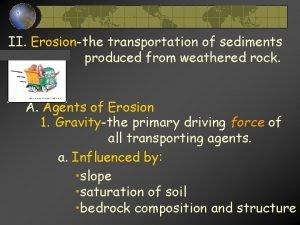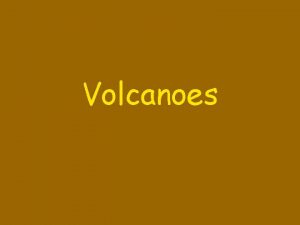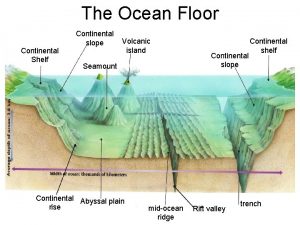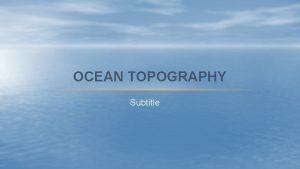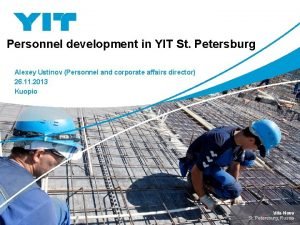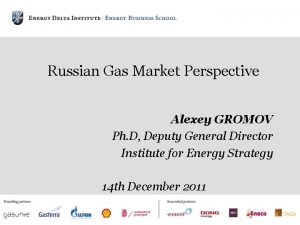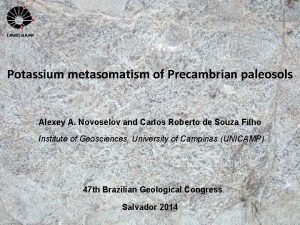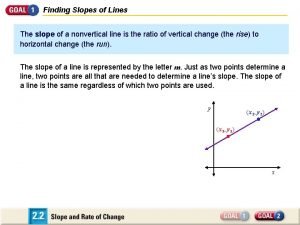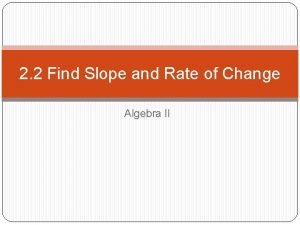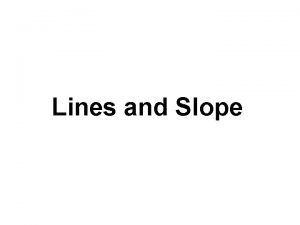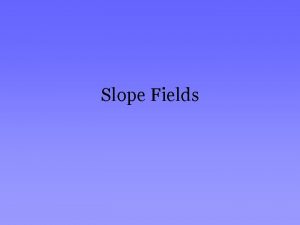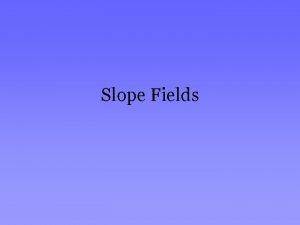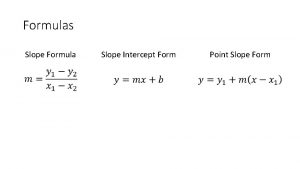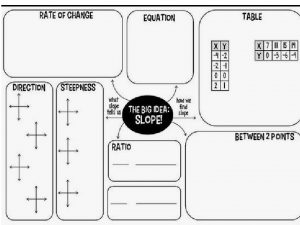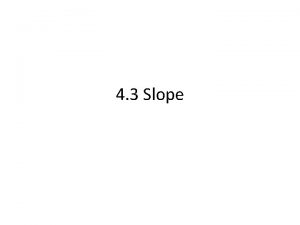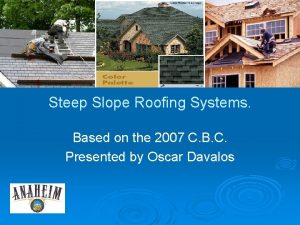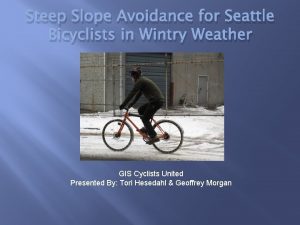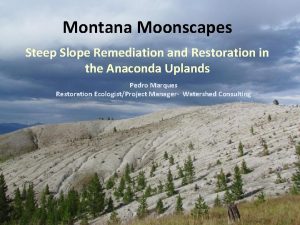Nonhydrostatic effects on the steep continental slope Alexey




















- Slides: 20

Non-hydrostatic effects on the steep continental slope Alexey Androsov, Naum Voltzinger, Vera Fofonova and Ivan Kuznetsov 28 -31 Januar 2020, Hamburg, Germany

Motivation Numerical models have become an key tool for ocean and coastal flow modeling. Such models typically use the hydrostatic approximation based on the argument that their horizontal length scales are longer than the vertical length scales. Many of physical processes in oceans and coastal zones are adequately modeled with the hydrostatic approximation, but there are phenomena when vertical acceleration is proportional with horizontal, and sometimes and exceeding it and then accounting of non-hydrostatic pressure is necessary. • Interaction barotropic tides with baroclinic waves on sharp topography. • Upwelling of cold water from subsurface • Sinking of surface water • Cascading processes • …

Hydrostatic & Non-hydrostatic 6 Red line – non-hydrostatic; blue line - hydrostatic; circles - observations. 12 17 distance, m

Poisson Equation (PE) and Predictor Correcto r

Numerical realization of the non-hydrostatic problem PE for the Beltrami-Laplace operator is solved iteratively with a change of direction at each iterative step and realized in form:

Lock-Exchange flow on the shelf break Initialization: Heggelund et al. , 2004. Initial experiment configuration with location for three stations for analysis. Total energy for hydrostatic and nonhydrostatic simulation.

Lock-Exchange flow on the shelf break Density fluctuations along the section at time=10 h Vertical velocity along the section at time=10 h

Lock-Exchange flow on the shelf break Maximal Norme (B 1) of difference for two simulations case. Non-hydrostatic & Hydrostatic.

Lock-Exchange flow on the shelf break Full pressure gradient. Left panel – 5 h; Middle panel – 7. 5 h ; Right panel – 10 h. Hydrostatic and Non-hydrostatic pressure for three differnt points.

Lock-Exchange flow on the shelf break Vertical velocity for two simulations for 10 hours simulations in the three points on the continental slope. Hydrostatic (back) & Non-hydrostatic (red). Vertical velocity for two simulations in the two points on the continental slope. Hydrostatic (back) & Non-hydrostatic (red). Wave character of the flow in the Non-hydrostatic case.

Lock-Exchange flow on the shelf break Vertical velocity in P 3 for hydrostatic experiment with high horizontal diffusion and vertical viscosity Total energy for different experiments for testing diffusion and viscosity. Hydrostatic experiment with high horizontal diffusion and vertical viscosity. Density fluctuations along the section at time=40 h

Lombok Strait: comparison hydrostatic and non-hydrostatic approaches The Lombok Strait, which has a complex morphometric structure and is an important link in the water exchange between the Pacific and Indian Oceans. Hoffmüller diagramm of the vertical velocity (Station 4). Left – non-hydrostatic; middle – hydrostatic; right – difference.

Lombok Strait: comparison hydrostatic and non-hydrostatic approaches Vertical velocity along the section 2. Upper panel – I energetic minimum it the tidal cycle M 2 wave; Bottom panel – I energetic maximum. Left – non-hydrostatic; middle – hydrostatic; right - difference

Lombok Strait: comparison hydrostatic and non-hydrostatic approaches kg/m 3 Difference section 2. dencity along the Hoffmüller diagramm of the Temperature (upper panel) and Salinity (bottom panel) for Station 4. Left – non-hydrostatic; middle – hydrostatic; right – difference.

Lombok Strait: comparison hydrostatic and non-hydrostatic approaches *St. 6 Spectral analysis of vertical velocity in hydrostatic / non-hydrostatic formulations

Lombok Strait: comparison hydrostatic and non-hydrostatic approaches Hydrostatic simulation. Left: amplitude vertical velocity on frequency M 2 wave. Right: amplitude for all nonlinearity frequency. Non-hydrostatic simulation. Left: amplitude vertical velocity on frequency M 2 wave. Right: amplitude for all nonlinearity frequency.

Can account for non-hydrostatic pressure “solve” the open boundary problem? Residual circulation for full domain Test experiment: 3 D barotropic task for narrow channel with sharp underwater mountain. On the open boundary – M 2 tide with 1 cm amplitude with opposite phase. Residual circulation for the north part of the channel. Red arrows – non-hydrostatic for full domain; black arrows – non-hydrostatic only in the region underwater mountain.

Future implementation Quads, triangles and mixed meshes FESOM-C* model § § A coastal branch of the FESOM 2 global model FESOM 2 and FESOM – C share a part of infrastructure Easy coupling with global version Easy implementation non-hydrostatic aproach from FD to FV. *Androsov et al. , GMD, 2019

Conclusions ü The neglect of non-hydrostatic pressure in a hydrostatic model is problematic since non-hydrostatic pressure plays a significant role in internal wave evolution balancing nonlinear wave steepening. ü Where non-hydrostatic pressure is neglected in a model it should not be surprising that the wave evolution may be poorly predicted. ü It is shown that hydrostatic models may develop high wavenumber “solitonlike” features that are purely a construct of model error but may seem to mimic physical behaviours of the non-hydrostatic system. ü Computation of complete equations for small regions with a strong influence of non-hydrostatics can significantly reduce problems with setting open boundary conditions.

Thanks for your attention
 Slope math definition
Slope math definition Steep slope
Steep slope A steep slope with a nearly flat plateau on top
A steep slope with a nearly flat plateau on top Small size steep slope bowl shaped opening volcano
Small size steep slope bowl shaped opening volcano Steep slope
Steep slope Convergent vs divergent boundaries
Convergent vs divergent boundaries Plate boundary
Plate boundary Long narrow cracks in the ocean floor
Long narrow cracks in the ocean floor Continental slope diagram
Continental slope diagram Alexey svyatkovskiy
Alexey svyatkovskiy Alexey ustinov
Alexey ustinov Alexey gromov
Alexey gromov Alexey belyanin
Alexey belyanin Alexey onufriev
Alexey onufriev Alexey onufriev
Alexey onufriev Alexey novoselov
Alexey novoselov Alexey burov
Alexey burov Inverse operations
Inverse operations Point-slope form definition geometry
Point-slope form definition geometry Slopes of lines
Slopes of lines Slope review classifying slope
Slope review classifying slope

